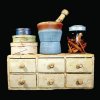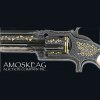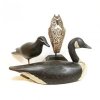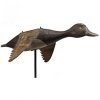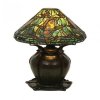Degrees of Good
August 19th, 2017
Ellsworth Antiques Show at Woodlawn, Ellsworth, Maine
The history of Woodlawn Museum in Ellsworth, Maine, goes back about 190 years to when lumber baron Colonel John Black built his monumental 180-acre estate. In 1928 his grandson George Nixon Black Jr. bequeathed the property to the Hancock County Trustees of Public Reservations, and it has remained open as a public park ever since. The museum is about to take another giant step forward, and the Ellsworth Antiques Show at Woodlawn, held this year August 17-19, will be an integral part of the change.
The museum is about halfway to its goal of raising $8 million for the complete removal and replacement of the 1830 carriage house that stands near the main house. The barn was downsized around 1940, and since then it has fallen into a state of disrepair. The master plan is to tear it down and replace it with a new one that conforms as closely as possible with the original structure.

The carriage house, as it stands now, will be replaced by a new one with the same footprint and conforming to the design of the original structure as closely as possible.

Bill and Arlene Schwind of W. M. Schwind, Jr. Antiques and Fine Art, Yarmouth, Maine, have been in business since 1967 and have been exhibiting at Woodlawn for seemingly that long. They brought a full-length primitive portrait of a charming young girl, attributed to Joseph Whiting Stock (1815-1855). Stock suffered a crippling accident at age 11, when an oxcart fell on him, and he was rendered a paraplegic. Stock was in ill health for most of his life and died of tuberculosis at the age of 40. But in his relatively short life, he produced over 900 portraits, mostly of young children and their families. The painting the Schwinds offered here for $9800 is strikingly similar to one that Stock produced of Mary Jane Smith of Springfield, Massachusetts, in 1838. “There is no question that it’s him,” Bill Schwind confirmed, citing several characteristic similarities between this painting and other documented Stock works.
Perennial exhibitor and museum trustee Wilmont “Bill” Schwind elaborated: “[The carriage barn] had a rubble foundation, and it was falling apart…. The sills were rotting.... It’s a mess.”
 The new structure will be large enough to house at least a portion of the 27-exhibitor show, along with a host of social, cultural, and educational functions. Other improvements are in the wind that will allow greater access year round to the land’s trails and ponds, and the antiques show will continue to be a part of the development. So Woodlawn will be expanding and renovating, but the show with 27 exhibitors will very likely remain the same size.
The new structure will be large enough to house at least a portion of the 27-exhibitor show, along with a host of social, cultural, and educational functions. Other improvements are in the wind that will allow greater access year round to the land’s trails and ponds, and the antiques show will continue to be a part of the development. So Woodlawn will be expanding and renovating, but the show with 27 exhibitors will very likely remain the same size.

Harry Hepburn of Hermitage Antiques, Harrison, Maine, promised, “This is a rare dresser. It’s a bowfront State of Maine, and I’ve never owned one before.” Flame birch grain, a conforming top, applied beaded molding, and short but full-size turned legs combined to make it worth $1675.

Sometimes things don’t have to be complicated. “It’s simply a ball,” Sabina Wood of Northeast Harbor, Maine, offered. “It was used for sport, like a soccer ball.” But the sealskin covering and the glass beadwork make the late 19th-/early 20th-century Eskimo plaything special enough for a $1450 price.

A pair of sailor-made English woollie pillows dating from the early 1900s, with yarn-work representations of small sailing craft, was $795 from Ed Miller of Pioneer Folk Antiques, Ellsworth, Maine.
This year, there was a small handful of new exhibitors, but historically, the only way in has been to replace someone who dropped out. The consensus is that the small size of the show will help maintain its elegant standards. There are no plans afoot to expand it.
Maine’s oldest, and indeed the nation’s oldest, summer antiques show will continue to thrive in its projected new environs. This year, the Bangor Symphony Orchestra String Quartet and the Acadia School of Traditional Music & Art added a touch of elegance to an already top-notch affair. “It’s always a good show,” Schwind concluded. “It’s just a matter of degrees of good.”
For more information, visit (www.woodlawnmuseum.com) or call (207) 667-8671.

A rack full of mocha pitchers with seaweed, earthworms, and other designs ranged from $450 for the small cups to $950 for the larger pitchers in the booth of Ted and Jennifer Fuehr of American Spirit Antiques, Shawnee Mission, Kansas. “It’s been good,” Jennifer reported. “It’s the first time for us.”

Tad Runge of A.E. Runge Jr. Oriental Rugs, Yarmouth, Maine, usually does great business spreading his “user friendly” camp and cottage rugs outside of the tented area. But this time the inclement weather forced him to turn more inward, at least temporarily. His Persian Heriz 9'9" x 6'6" carpet in unfaded natural colors, circa 1930, was priced at $5250.

These might be called the trompe l’oeil of furniture painting. The pair of English cabinets (one shown) was so realistically painted that you might almost swear you were looking through a glass door to the books inside. Bob Withington and Laura Carrigan of Withington & Company, Portsmouth, New Hampshire, offered them for $3100.

Eric Hudson (1864-1932) painted along the entire northeastern seaboard from New York to Maine. Monhegan Island and Rockport, Maine, were two of his favorite haunts. This 14" x 20" oil on canvas, Waiting for Spring, priced at $6500 by Gleason Fine Art, Inc., Boothbay Harbor, Maine, may have reflected one of those locations.

No burglar would dare invade a home where these two brutes stood guard. Bruce Emond of Village Braider Antiques, Plymouth, Massachusetts, had the pair of enormous bronze garden lions and would part with his pets for $9200.
“It took three guys to move them,” he reported. “They’re hollow but they’re thick…. They came out of Essex, Connecticut, and they’re maybe fifty, sixty years old.”

Malcolm Magruder of Millwood, Virginia, offered a rare full-bodied and highly detailed grasshopper weathervane, attributed to Cushing & White of Waltham, Massachusetts, around 1880. In a thoroughly weathered verdigris patina, it was $16,500. You have much to earn, grasshopper.

Donald Heller of Heller Washam Antiques, Portland, Maine, had an enormous late 18th-century two-part apothecary chest, consisting of 34 paint-labeled drawers in the upper section surrounding a pair of blind-panel doors covering a central cupboard, with larger drawers and similar doors in the lower portion and a pullout mixing slide, all worth $16,800. The people Heller acquired it from had purchased it during World War II and had to haul it by horse wagon, since there was no gas available because of rationing.
Originally published in the November 2017 issue of Maine Antique Digest. © 2017 Maine Antique Digest
